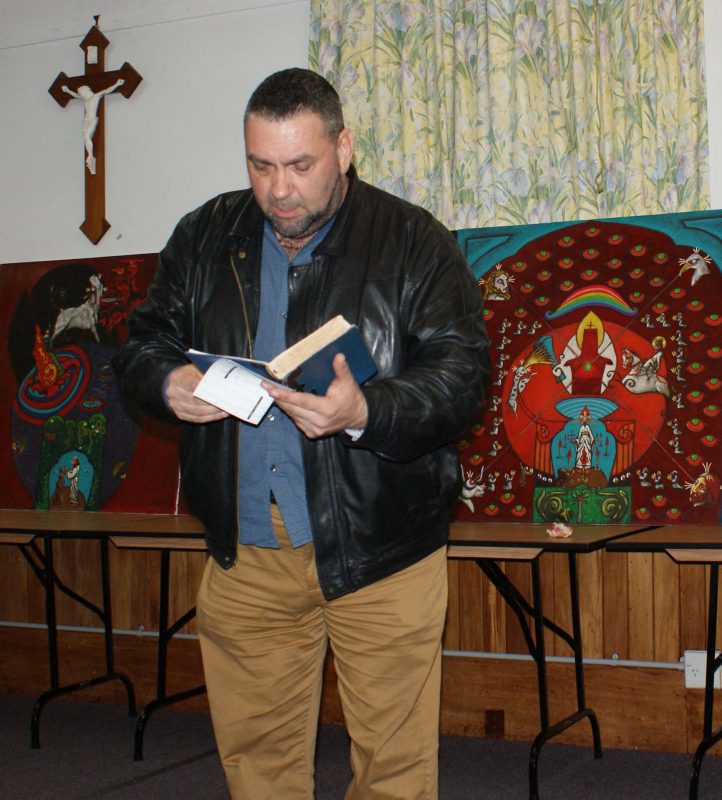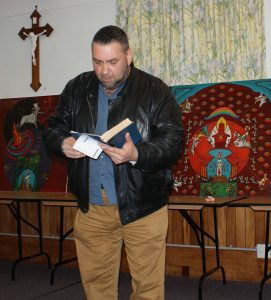by ROWENA OREJANA
One can find the Eucharist in the Book of Revelation if one looks hard enough.
The inaugural winner of New Zealand’s Most Inspiring Teacher, Robert Loretz, talked about the Eucharist and the Book of Revelation at the open teaching night held by the Catholic Discipleship College on August 5 at St Joseph’s Centre in Takapuna. Mr Loretz studied with
the Community of St John in France for three years.
“It’s a vision, obviously, and a very symbolic vision. And therefore, one of those kind of books that we don’t tend to read for relaxation,” he said. “We need help to get into the Book of Revelation. Once we get some help, though, it’s a life-changing book.”
Starting from Chapter 2, which contains the letter to the Church of Ephesus, Mr Loretz said the “he” who walks around seven lampstands with seven stars in his hand is Jesus walking around seven Churches (lampstands) while the stars represent the angels assigned to the churches.
“He (Jesus) says, ‘I know your works, your toil and your patient endurance. And how you cannot bear evil men but have tested those who call themselves apostles, but are not, and found them false. I know you are enduring patiently and bearing up for my name’s sake and you’ve not grown weary.’ So it’s quite beautiful,” he said.
“But he (Jesus) says, ‘I have this against you. You have abandoned the love you have at first,’” said Mr Loretz. “They are cutting words.”
Mr Loretz said the criticism of the Church is that it has forgotten the love it had at first, the love that was full of fervour and zeal and attention.
“Remember then from where you have fallen; repent and do the works you did at first,” he quoted.
“And what is the main work? Adoration. He says if you don’t do that I will come to you and remove your lampstand from its place, which means the lampstand is the Church, so the faith will go from that place. And we have to realise that’s possible in anyone’s heart and
it’s possible in any city.”
As he read from the second chapter, Mr Loretz explained that those who go back to adoring God will be given access to the “tree of life, which is the paradise of God”. The access to the tree of life in paradise was lost in the fall from grace by Adam and Eve. By contemplating and adoring God, we begin to understand that he is our Creator.
“God created directly our soul. When God makes our soul he holds us in being. That means if he stops holding my soul in being I would cease to exist. That means my soul is in direct contact with him right now. He is holding each person in being right now. He holds
us in existence,” he explained. “And when we realise that, we find ourselves suspended in God’s hand and needing to offer ourselves back.”
Christian adoration, he explained, has another dimension: God the Son. Jesus, he said, is not created but comes from the Father himself and continually gives himself to the Father. And the love between the two is the fullness of God the Holy Spirit.
“What’s Christian adoration? It’s somehow what the son lives when he gives himself to God the Father when he became a man. He still lived it but he lived it in the flesh. When he died on the cross he still lived it but he died in the flesh. On the cross he gave himself back in the agony of feeling all the sins of the world, but he is still giving himself back. He’s constantly done that. And as he does it, he gives himself up to God and he gives himself out to us,” Mr Loretz said.
Mr Loretz moved on to Chapters four and five of the book, which describe a throne where God sits, seven torches that are the spirits of God, the four living creatures (the lion of Judah, the ox of sacrifice, the merciful face of a man and the eagle contemplating and
soaring to the Father).
On the right hand of the one seated on the throne was a scroll that no one could open and therefore no one could read. St John bitterly wept, but was assured by an elder that the Lion of Judah can open it.
St John next saw, though, not a lion but “a lamb standing as though it had been slain with seven horns and seven eyes”, which meant perfect power and perfect vision of the truth, said Mr Loretz.
In these chapters, there are two songs, one to the Father and another to the Son.
The song to the Father sung by the Son goes “Holy, holy, God Almighty, who was and is and is to come”, Mr Loretz said, which was the way we were greeted in the first chapter by the Father.
To the lamb, on the other hand, which was slain but is alive, “they sing a new song. Worthy art thou to take the scroll and open its seals, for thou were slain and by thy blood didst ransom men for God”, Mr Loretz noted.
He explained that, Jesus, the lamb that was slain but is alive, “is not dead in the Mass, there’s a full living Christ in the body and the full living Christ in the blood, but we’re signing his death. That means the full power of his death which is present in his body living is given to us.”
He says the elders fall down to worship the Lamb. And this is why we go to Mass, he said. “You are closer to God when the body and blood of the Lord is offered by him to the Father and we are in the offering. You can’t get closer than that.”


Reader Interactions